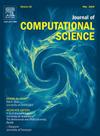研究二维脆性裂缝随机场能释放率的替代模型
IF 3.7
3区 计算机科学
Q2 COMPUTER SCIENCE, INTERDISCIPLINARY APPLICATIONS
引用次数: 0
摘要
本文提出一种加权变分模型作为近似替代模型,以降低脆性断裂模拟的数值复杂度和执行次数。因此,当能量释放率作为随机场建模时,脆性断裂的蒙特卡罗研究成为可能。在加权变分模型中,我们提出了一个带mat本文章由计算机程序翻译,如有差异,请以英文原文为准。
A surrogate model for studying random field energy release rates in 2D brittle fractures
This article proposes a weighted-variational model as an approximated surrogate model to lessen numerical complexity and lower the execution times of brittle fracture simulations. Consequently, Monte Carlo studies of brittle fractures become possible when energy release rates are modeled as a random field. In the weighed-variational model, we propose applying a Gaussian random field with a Matérn covariance function to simulate a non-homogeneous energy release rate () of a material. Numerical solutions to the weighed-variational model, along with the more standard but computationally demanding hybrid phase-field models, are obtained using the FEniCS open-source software. The results have indicated that the weighted-variational model is a competitive surrogate model of the hybrid phase-field method to mimic brittle fractures in real structures. This method reduces execution times by 90%. We conducted a similar study and compared our results with an actual brittle fracture laboratory experiment. We present an example where a Monte Carlo study is carried out, modeling as a Gaussian Process, obtaining a distribution of possible fractures, and load–displacement curves.
求助全文
通过发布文献求助,成功后即可免费获取论文全文。
去求助
来源期刊

Journal of Computational Science
COMPUTER SCIENCE, INTERDISCIPLINARY APPLICATIONS-COMPUTER SCIENCE, THEORY & METHODS
CiteScore
5.50
自引率
3.00%
发文量
227
审稿时长
41 days
期刊介绍:
Computational Science is a rapidly growing multi- and interdisciplinary field that uses advanced computing and data analysis to understand and solve complex problems. It has reached a level of predictive capability that now firmly complements the traditional pillars of experimentation and theory.
The recent advances in experimental techniques such as detectors, on-line sensor networks and high-resolution imaging techniques, have opened up new windows into physical and biological processes at many levels of detail. The resulting data explosion allows for detailed data driven modeling and simulation.
This new discipline in science combines computational thinking, modern computational methods, devices and collateral technologies to address problems far beyond the scope of traditional numerical methods.
Computational science typically unifies three distinct elements:
• Modeling, Algorithms and Simulations (e.g. numerical and non-numerical, discrete and continuous);
• Software developed to solve science (e.g., biological, physical, and social), engineering, medicine, and humanities problems;
• Computer and information science that develops and optimizes the advanced system hardware, software, networking, and data management components (e.g. problem solving environments).
 求助内容:
求助内容: 应助结果提醒方式:
应助结果提醒方式:


